
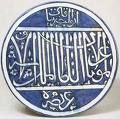






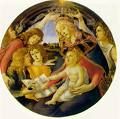

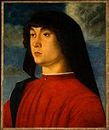
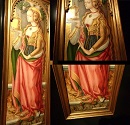
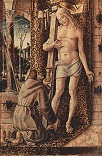

1480 I find that only stupid people are breeding? The Ottomans literally scare the Christians into getting over their fear of falling off the edge of the Earth and discovering America? In May-Aug. the Ottomans siege Rhodes, the last major Aegean island not under their control, but the Knights of St. John fight them off after causing heavy losses; on Aug. 11 after sieging them since July, the Ottomans surprise-attack and sack Otranto in Apulia, S Italy, killing 12K of 22K inhabitants and hauling away 5K in chains, then on Aug. 14 ritually decapitate 800 Christians who refuse to accept Islam in the Valley of the Martyrs in Otranto, sawing archbishop Stephen Pendinelli and garrison cmdr. Count Francesco Largo in half, threatening Italy with conquest, and causing Western navigators to begin turning around, "Seeking the East by Way of the West", i.e., finding a westward passage to the Indies; meanwhile the pope calls for a guess what, a Crusade; on Feb. 28, 2013 Pope Benedict XVI canonizes 800 of the Italian martyrs. In Nov. after grand prince (since 1462) Ivan III the Great (1440-1505) of Moscow tells the Tartar Great Horde Khan Akhmat to stuff it and refuses the customary tribute payment, causing Akhmat to pass through the Lithuanian territories of his ally Casimir IV to the Muscovite border on the Ugra River, Ivan II makes use of artillery to defeat his horseback archers and turn them back, ending Moscow's subservience to the Tartars. The last Norse Greenland colony becomes extinct. James III of Scotland, known for requesting frequent taxation so that he can hoard the money issues a debased copper currency, which becomes known as the "black money"; meanwhile his brother Earl John of Mar criticizes James III, and is forfeited then killed under suspicious circumstances, while his other brother (2nd son of James II and Mary of Gueldres) Alexander Stewart, 1st Duke of Albany (1454-85), who also criticized him flees into exile in France, and plots a comeback, becoming the leader of a planned coup; meanwhile James III forces his elder sister Mary to marry old fart Lord Hamilton, pissing her off, causing his younger sister Margaret to have a love baby with Scottish chancellor William Crichton, 3rd Lord Crichton (-1493) (who maintains cool Crichton Castle in Midlothian S of Edinburgh) to avoid another forced marriage to another old fart, getting exiled to Tain; too bad, Crichton causes his lordship (begun 1443) to become forfeited in 1484. The Maravi Kingdom is founded in the Shir River Valley in Malawi, Africa. Inca emperor #10 (1471-93) Topa Inca Yupanqui and his army make a 10-mo. voyage over the Pacific in a fleet of balsa wood rafts about this time? Egyptian Mamluk Sultan Qaitbay constructs a fort on the site of the Alexandrian Lighthouse, using fallen stone and marble from it. The port of Gijon (Gijón) in NW Spain is rebuilt to handle oceangoing traffic. Prince Henry the Navigator founds a school for navigation in Portugal. Yolande (Iolande) de Bar, Duchess of Lorraine (1428-83) succeeds her father Rene I of Anjou as grandmaster of the Priory of Sion (until 1483), which is expanded to 27 commanderies :). Architecture: Donato Bramante d'Agnolo (Lazzari) (1444-1514), who spent from 1472-77 painting works in Milan and Bergamo devotes himself to architecture, beginning with the Church of Santa Maria Presso di San Satiro in Milan (S of the Duomo) (finished 1488). In this decade Rosslyn Chapel in Midlothian S of Edinburgh in Scotland (begun in the 1440s) is finished by Oliver Sinclair; his grandson Oliver Sinclair III goes on to command the Scottish army at Solway Moss in 1542. Science: Arculanus (1412-84), prof. of medicine in Bologna and Padua describes a method of filling decayed teeth with gold foil. Nonfiction: Cardinal Pierre d'Ailly, Imago Mundi; quotes Roger Bacon's "Opus Maius" (1267), Pt. IV: ("The sea between the end of Spain on the west and the beginning of India on the east is navigable in a very few days if the wind is favorable"), later cited by Columbus in 1498 in a letter to Ferdinand II and Isabella I. Hans Folz (1437-1513), Baderbuchlein; begins reforming the songs of the Meistersingers to incl. worldy subjects. Giovanni Pico della Mirandola (1463-94), Heptaplus: Discourse on the Seven Days of Creation. Art: Gentile Bellini (1427-1507), Sultan Mehmed II. Giovanni Bellini (1430-1516), Portrait of a Young Man in Red. Sandro Botticelli (1445-1510), St. Augustine; Madonna of the Magnificat (1480-1). Piero di Cosimo (1462-1521), Simonetta Vespucci. Carlo Crivelli (1430-95), Mary Magdalene; ends up in the Rijksmuseum in Amsterdam; St. Francis with the Blood of Christ (1480-6). Domenico Ghirlandaio (1449-94), The Last Supper; Old Man With a Young Boy. Martin Schongauer (1448-91), The Temptation of St. Anthony (engraving) (1480-80). Births: Italian Roman Catholic cardinal Girolamo (Hieronymus) (Jerome) Aleandro (Aleander) (d. 1542) on Feb. 13 in Motta (near Venice); first cardinal appointed "in pectore" (close to the breast, i.e., in secret). Italian conspiracy queen and patroness of the arts (duchess of Ferrara) Lucrezia Borgia (d. 1519) on Apr. 18 in Rome; illegitimate daughter of Rodrigo Borgia (Pope Alexander VI) (1431-1503) and Vanozza Catanei (1442-1518); sister of Cesare Borgia (1476-1507). Portuguese explorer-writer Duarte Barbosa (d. 15221) in Lisbon; brother-in-law of Ferdinand Magellan. Portuguese navigator-explorer Ferdinand Magellan (Fernao de Magalhaes) (d. 1521) in Sabrosa, Tras-os-Montes e Alto Douro; studies in the Portuguese royal court as a child, where he learns mapmaking, astronomy, and navigation. Italian painter (gay) (lover of Leonardo da Vinci) Gian Giacomo Caprotti da Oreno (d. 1524) (AKA Andrea Salai and Il Salaino = "Little Unclean One") in Oreno (near Monza), Vimercate; student of Leonardo da Vinci. Italian painter Palma Vecchio (Jacopo Palma) (Jacopo Nigreti) (d. 1528) in Serina (near Bergamo); granduncle of Palma Giovane (1544-1628); known for his golden glow. Spanish explorer Diego de Ordaz (Ordás) (d. 1532) in Castroverde de Campos, Zamora. German painter-printmaker-architect Albrecht Altdorfer (d. 1538) near Regensburg. Italian metallurgist ("Father of the Foundry Industry") Vannoccio (Vannocio) Biringuccio (d. 1539) in Siena. French portrait painter Jean (Janet) Clouet (d. 1541); of Flemish descent; father of painter Francois Clouet (1510-72). Spanish sculptor Damia (Damiŕ) Forment (d. 1540) in Valencia. German magician Johann Georg Faust (John Faustus) (d. 1541); the real Faust? Lithuanian grand hetman (1531-41) Jerzy Radziwill (d. 1541). Turkish Alevi Sufi ashik (minstrel-composer) Pir Sultan Abdal (d. 1550). Italian painter Lorenzo Lotto (d. 1556) in Venice. Italian fairy tale writer Giovanni Francesco "Gianfrancesco" Straparola (d. 1557) in Caravaggio. Franco-Flemish Renaisance singer-composer Benedictus Appenzeller (d. 1559) in S Netherlands. Irish king of Tir Eogain Conn O'Neill, 1st Earl of Tyrone (d. 1559); father of Shane O'Neill (1530-67); grandfather of Hugh O'Neill (1550-1616). French publisher and type designer Claude Garamond (d. 1561). German knight Gotz (Götz) von Berlichingen (d. 1562) in Berlichingen, Wurttemberg. Deaths: French "Good King" of Naples (1438-42) and duke of Anjou (1434-80) Rene I of Anjou (b. 1409) on July 10 in Aix-en-Provence. French painter Jean Fouquet (b. 1416).





1481 On May 3 sultan (since Feb. 3, 1451) Mehmed II the Conqueror (b. 1432) dies suddenly, and on May 22 his son Bayezid (Bajazet) II (the Just) (1447-1512) becomes Ottoman sultan #8 (until Apr. 24, 1512) after his pretender younger brother Cem (Jem) (Zizim) (1459-95) (gov. of Karaman in Konya since Dec. 1474) has grand vizier Karamanli Mehmet Pasha transport Mehmed II's body to Constantinople and let it lie in state for three days in violation of Islamic law so that he can get there first and become sultan, only to see his vizier lynched by the Janissaries after they find out and break into the capital, after which Bayezid II arrives on May 21 and is declared sultan on May 22, but on May 27 Cem captures Inegol with a 4K-man army, then on May 28 defeats an army sent by Bayezid II under new vizier Ayas Pasha and declares himself sultan of Anatolia, with capital at Bursa, proposing to divide the empire and give the Euro side to Bayezid II, pissing him off and causing him to utter the soundbyte: "Between rulers there is no kinship"; on June 20 Cem is defeated near Yenishehir in Bursa opposite Constantinople and flees with his family to Mamluk Cairo, seeking protection from the Knights of St. John in Rhodes, who hand him over to Pope Innocent VIII, who tries to use him as a figurehead for a new papal crusade that fails to materialize, and ends up dying in a prison in Naples where Bayezid II pays them to keep him imprisoned; meanwhile on Sept. 11 the Ottoman forces in the Otranto Strait between Albania and Italy surrender to the Christian Aragonese, leaving the Ottoman Empire in disorder while Bayezid II enters a rebuilding period and tries to free himself of the Janissaries, campaigning against the Venetian possesssions in Morea and gaining control of the whole Peloponnese in 1501, facing rebellions in the east by the pesky Qizilbash and their backer Shah Ismail of Persia. On May 21 Christian I (b. 1426) dies after paying his debts and solidfying his reign, and his son Hans (Johannes) (John) (1455-1513) becomes king of Denmark, followed by Norway in 1483; too bad, Sweden holds out, and regent Sten Sture stays in power (until 1497). In the summer the Venetians invade Florence, and are defeated at the Battle of Cento. On Aug. 28 king (since Sept. 13, 1438) Alfonso V (b. 1432) dies in a monastery in Sintra, and his son Joao (John) II "the Perfect Prince" (1455-95) becomes lucky king #13 of Portugal, going on to reestablish the power of the Portuguese monarchy, reinvigorate the economy, and renew exploration of Africa and the East, also becoming the one to snub Columbus then get smart and work to get Portugal's hands on the dark Christless New World and perfect it? On Dec. 26 the Granadans under Emir Abu Hasan surprise the Castilian garrison of Zahara on a stormy night, and enslave the pop. A Crusader force led by Ferdinand I of Naples allied with Matthias Corvinus of Hungary kicks Turk butt and recaptures Otranto, although it is now kaput and never recovers its importance. The last fort in Hercegovina falls to the Turks. Solothurn NE of Lake Neuchatel joins the Swiss Confederation. Provence passes from the House of Anjou (since 1246) to the French crown. Axayacatl dies, and his younger brother Tizoc (Tizocic) (Tizocicatzin) (-1486) becomes king #7 of Tenochtitlan in Mexico (until 1486). The Galatasaray Lycee in Constantinople opens as a palace school to train young men for Ottoman service. Nonfiction: Herbarium of Apuleius (Rome). Art: Sandro Botticelli (1445-1510), The Temptation of Christ (Sistine Chapel) (1481-2). Leonardo da Vinci begins work on the pen-and-ink altarpiece The Adoration of the Magi for the monastery of San Donato a Scopeto in Florence (his first large painting, which he leaves unfinished in 1482); he writes a letter to Duke Ludovico Sforza the Moor of Milan claiming that he could construct various war machines as well as sculpt in marble, bronze and clay, causing the duke to hire him, and he leaves Florence for Milan (until 1499). Verocchio, Bartholomeo Colleoni (statue) (Venice). The original Frescomania? Sandro Botticelli (1445-1510), Ghirlandaio (1449-94), Signorelli, Perugino and his asst. Pinturicchio (Bernardino di Betti) (1454-1513) begin painting Scriptural Frescoes in the Sistine Chapel in Rome (until 1482), incl. Perugino's Christ Giving the Keys to St. Peter. Births: German knight Franz von Sickingen (d. 1523) on Mar. 2 in Ebernburg (Bad Munster am Stein-Ebernburg) (near Bad Kreuznach). Italian architect-painter Baldassare Tommaso Peruzzi (d. 1536) on Mar. 7 near Siena; father of Giovanni Sallustio Peruzzi (1511-73). German Wittelsbach bishop of Freising (1495-8) Count Ruprecht of the Palatinate (d. 1504) on May 14 in Heidelberg; husband (1499-) of Elisabeth of Bavaria-Landshut (1478-1504), daughter of Duke George the Rich of Bavaria-Landshut; father of Otto Henry (1502-59) and Philip the Contentious (1503-48). Danish-Norwegian (1513-23) and Swedish (1520-21) king Christian II (the Tyrant) (d. 1559) on July 1 at Nyborg Castle; son of John of Denmark and Christina of Saxony. Italian painter Benvenuto (Tisi) (Tisio) da Garofalo (d. 1559) in Garofalo (near Ferrara); pupil of Lorenzo Costa and Dosso Dossi. Spanish Franciscan historian-moralist (court historian to HRE Charles V) Antonio de Guevara (d. 1545) in Treceno, Cantabria; cousin of Diego de Guevara (1450-1520). Deaths: Italian humanist scholar Francesco Filelfo (b. 1398) on July 31 in Milan (plague). Italian painter Sano di Pietro (b. 1406). Gujarat singer Narsi Mehta (b. 1414). Portuguese explorer Afonso Goncalves Baldaia (b. 1415) in Praia da Vitoria, Azores. Italian Vatican librarian Bartolomeo Platina (b. 1421) on Sept. 21 in Rome. Danish-Norwegian-Swedish king Christian I (b. 1426) on May 21 in Copenhagen. Portuguese king (1438-81) Alfonso V (b. 1432) on Aug. 28 in Lisbon. Ottoman sultan #7 (1444-6, 1451-81) Mehmed II the Conqueror (b. 1432) on May 3 in Hunkarcayiri (near Gebze).




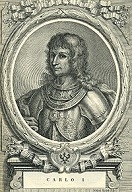




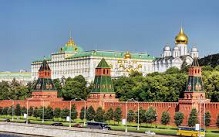
1482 On Jan. 6 the Feast of Fools in Paris is a big day for foundling bellringer Quasimodo, the Hunchback of Notre Dame, archbishop Charles II of Bourbon (1434-88) of Lyons, et al. :) On Feb. 25 Spanish forces under Rodrigo Ponce de Leon, the Marquis of Cadiz gather at Marchena, march to Antequera, cross the Sierra Alzerifa, and seize Granadan Alhama on Feb. 28; Abu Hasan attempts to retake it by siege on Mar. 5-19, then withdraws to Granada; Muslim troops from Ronda raid the Arcos area in an attempt to tempt the marquis out of Alhama; in support of his men at Alhama, King Ferdinand of Aragon marches to Lucena, sends reinforcements into Alhama on Apr. 30, withdraws to Cordoba to organize a major force, and then formally takes over Alhama on May 14. On Mar. 27 Mary of Burgundy (b. 1457) dies after falling off a horse (on her little arras?), and her husband Archduke Maximilian of Austria is forced to accept the Treaty of Arras with Louis XI and the Low Countries, giving Louis XI the duchy of Burgundy, while Maximilian gets a good sized chunk, incl. Brabant, Limburg, and Namur, which eventually (1512) become known as the Circle of Burgundy; Mary's 4-y.-o. son Philip I of Castile (b. 1478) becomes duke of Burgundy, and is held prisoner by the govt. of the city of Ghent, which objects to Maximilian's claim to be regent for him and claims it's only an excuse to claim control of the Low Countries. Ivan III officially renounces the Mongol khanate rule over Russia. Jem tries to set up his own sultanate in Anatolia again, and this time goes into exile in Europe where he is used as a pawn by the Catholic rulers until his death in 1495. In May after relations between James III and Edward IV deteriorate, Duke Alexander of Albany, backed by James III's enemies returns from exile in France, concludes the Treaty of Fotheringhay with Edward IV in June, and leads a revolt against his brother James III, along with James' three half-uncles (sons of Joan Beaufort by her second husband James Stewart of Lorne) Earl John of Atholl, Earl James of Buchanan, and Bishop Andrew of Moray, his elder sister Mary, and his own wife Margaret of Denmark; in July an English army of 20K led by Duke Richard of Gloucester invades Scotland (first time since 1400) to support the revolt, and seizes James III at Lauder, while the Scottish army is dispersed by its leaders Colin Campbell, 1st earl of Argyll and Earl Archibald of Angus after executing some of its members, gaining them the epithets "bell the cat" and "low-born"; Albany at first claims to be king Alexander IV, then settles with the title of lt.-gen. of Scotland, with backing from the queen. In the summer Portuguese navigator Diogo Cao (Diego Cam) (1452-86) becomes the first European to sight and enter the Congo River, discovering Angola (1482-4). On July 1 King Ferdinand of Aragon attacks the Granadan city of Loja; the city is defended by the octogenarian father-in-law of Muhammad XII, Ibrahim Ali al-Attar; Ferdinand returns to Cordoba; Abu Hasan marches on Loja and sweeps the Rio Frio in mid-July. On Sept. 10 Federico III da Montefeltro (b. 1422) dies, and his 10-y.-o. son Guidobaldo I da Montefeltro (1472-1508) becomes duke of Urbino in Italy (until 1508), turning his court into a center of art and lit., home of historian Polydore Vergil (1470-1557), Baldassare Castiglione et al. The Spanish endgame in Granada begins (ends 1492)? Moorish Sultan Muhammad XI (d. 1538) (AKA Boabdil by the Spanish, a corruption of the name Abu-Abdullah) (AKA El Chico or "the Little" by the Moors) seizes the throne of Granada from his father Muley Abu'l Hassan, and plunges Granada into civil war at the time the Christians of Castile and Aragon are beginning their attack on the kingdom. Girolamo Savonarola (1452-98) starts his preaching work against the pagan (Platonic, not Aristotelian - that was Milan) life of the Renaissance at the court of the Medicis in Florence, trying to "keep the Devil off his shoulder"; decadent Lorenzo de' Medici becomes his focus of all that is sinful, and he succeeds in splitting Florence down the middle? Matthias Corvinus of Hungary begins a 3rd War Against HRE Frederick III. Muhammad III (b. 1454) dies at age 28 of alcoholism and remorse after killing his best minister Mahmud Gavan, builder of the quadrangular College of Bihar; Muhammad's incompetent son Mahmud (-1518) becomes ruler of Bidar in Deccan, India, becoming the prisoner of his minister Kasim Barid. Duke William III (younger brother of Elector Frederick II) dies, and Saxony annexes Thuringia. After childless Queen Charlotte surrenders her rights to her nearest legitimate heir Charles I (the Warrior) (1468-90), son of Duke Amadeus IX of Savoy and Yolanda of Valois, daughter of Charles VII of France, he becomes duke of Savoy (until Mar. 13, 1490), although the Repub. of Venice holds it under protest of the House of Savoy; in 1485-90 he becomes titular king of Cyprus, Jerusalem, and Armenia. The town of Accra ("ants") on the N coast of the Gold Coast (Gulf of Guinea) is founded by the Portuguese as a fort and trading post. Berwick-upon-Tweed, which for cents. was considered the E end of the boundary between England and Scotland and part of neither (a "county of itself") is finally claimed decisively by the English. Swiss Dominican scholar Felix Fabri (1441-1502) visits Jerusalem, describing it as "a collection of all manner of abominations", incl. Saracens, Greeks, Syrians, Jacobites, Abyssianians, Nestorians, Armenians, Gregorians, Maronites, Turcomans, Bedouins, Assassins, a sect (Druzes?), Mamluks, and "the most accursed of all", Jews, whom the Muslims treat like merde, along with Latin Christians, who "long with all their hearts for Christian princes to come and subject all the country to the authority of the Church of Rome"; when/if they make it to the Holy Sepulchure the Christians go apeshit, making "such bitter heartfelt groans, such sweet wailings, and such deep sighs, such sorrow, such sobs from the inmost breast, such peace and gladsome solace" that he gags, finding the pilgrimage around the holy sites, with mandatory kneeling and prostration a drag, with the soundbyte: "To struggle after mental abstraction while boldly walking from place to place is exceedingly toilsome", also questioning the historicity of the Tomb of David and other sites. Leonardo da Vinci moves to the Sforza court in Milan, where he stays for 18 years, playing his lyre for the duke while compiling his Notebooks (finished 1510); the duke commissions him to make an equine statue that will be the largest in the world; a clay cast is made over the next 16 years but the bronze is appropriated for cannons and the clay cast destroyed when the duke's castle falls to French invaders. Florentine painter Cosmo di Lorenzo Filippi Rosselli (1439-1507) and his boiled-egg-loving pupil Piero di Cosimo (1462-1521) go to Rome and begin painting frescoes in the Vatican's Sistine Chapel; later Cosimo returns to Florence and develops a rep for originality. Architecture: Elmina Castle (originally Castelo de Sao Jorge da Mina) (St. George of the Mine Castle) in Ghana, Africa is built by Portuguese traders, going on to become the #1 slave-trading post in the world. The Ginkaku Temple (Silver Pavilion) in Kyoto, Japan is built; the shogun who builds it dies before its completion, so there really is no silver? The Moscow Kremlin (Russ. "fortress inside a city") in Moscow, Russia is begun (finished 1495). Nonfiction: The earliest printed Latin ed. of Euclid appears in Venice. Hyginus, Poeticon Astrononomicon de Mundi et Sphaera (Venice). Ptolemy's Map of the World is pub. in Ulm. The Poeticon Astronomicon, a map of the constellations is pub. in Venice. An Italian ed. of John Peckham's Perspectiva Communis is pub., influencing Leonardo da Vinci to study Greek geometry in an attempt to improve his theory of lenses and the eye incl. the camera obscura. Art: Sandro Botticelli (1445-1510), Adoration of the Magi (Sistine Chapel). Births: German Protestant theologian Johannes Oecolampadius (Oekolampad) (Huessgen) (Hussgen) (Hausschein) (d. 1531) in Weinsberg. Hungarian Roman Catholic cardinal-statesman George (Gyorgi) Martinuzzi (AKA Frater Georgius) (d. 1551) in Kamicac, Dalmatia; real name is George Utjesenovich, but he changes it to his Venetian-born mother's name; educated in the Pauline Monastery of St. Laurentius near Ofen. Deaths: Italian cartographer Paolo Toscanelli (b. 1397) on May 15; his mistranslated Muslim maps showing Asia 3K mi. W of Europe get Christopher Columbus started. Italian sculptor Luca della Robbia (b. 1399) in Florence. Italian duke Federico III da Montefeltro (b. 1422) on Sept. 10 in Ferrara. English queen consort Margaret of Anjou (b. 1429) on Aug. 25 in Anjou, France; bured in Anjou. Flemish painter Hugo van der Goes (b. 1440). French Renaissance supermodel Mary of Burgundy (b. 1457) on Mar. 27.







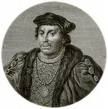

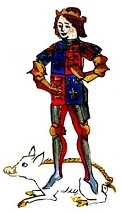

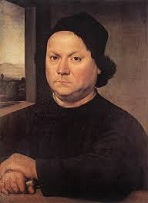
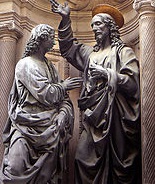

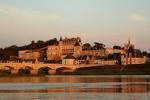

1483 On Mar. 19 after a fast-moving Castilian force under Alonso de Cardenas, master of Santiago and Don Pedro Henriquez, marquis of Cadiz raid the mountainous sierra of Axarquia, Granadan horsemen from Malaga under Abd-Allah al-Zagal (the future Muhammad XIII) ambush the Castilian rear guard, after which the Battle of Axarquia sees elements of the Castilian main body under the marquis of Cadiz attempt to rescue them, losing 800 KIA and 1.6K captured, becoming the last Muslim V in Spain; on Apr. 8 King Ferdinand II ravages the area around Illora, then Tajar on Apr. 14, and resupplies the Alhama garrison on Apr. 16; meanwhile 10K Granadans under Muhammad XI (Boabdil) siege Lucena, after which a 1.5K-man relief force under the count of Cabra marches from Baena and surprises the Granadan camp on Apr. 20, and the Granadan horses are Tolkiened (like the Nazgul in "Fellowship of the Ring") when they reach the rain-swollen river Xenil, and 5K Granadans are killed or captured; Ibrahim Ali al-Attar, Muhammad's father-in-law is killed on Apr. 21; Boabdil becomes the first king of Granada to be captured by the Christians; he is released on condition that he hold Granada as a tributary kingdom under Ferdinand II. A bush in the hand is better than a bird in the cradle? On Apr. 9 after Maximilian of Austria accepts the acquisition of Burgundy by France, and ailing French King Louis XI (b. 1423) decides that 3-y.-o. Margaret of Austria (1480-1530), daughter of Maximilian I and Mary of Burgundy would be a better wife for the dauphin than 17-y.-o. Elizabeth of York (1466-1503), eldest daughter of Edward IV and Elizabeth Woodville, to whom he was previously engaged, because she brings as dowry Franche-Comte and Artois, pissing him off to see his daughter jilted, causing him to declare war on France, English king (since Mar. 4, 1461) Edward IV (b. 1442) dies suddenly a few days short of his 41st birthday (Apr. 28), leaving behind two sons, Edward V (b. 1470) and Duke Richard of York (b. 1473), and five daughters; on Apr. 9 12-y.-o. Edward V (1470-83) is declared the 37th monarch of England (until June 25), but before the Woodville clan (who has him in their care) can get him crowned, Edward IV's brother Duke Richard of Gloucester, who had been named protector by the deceased king seizes him at Stony Stratford on Watling St. near Northampton on Apr. 30, and imprisons him with his guardian (maternal uncle) Anthony Woodville, 2nd Earl Rivers (1442-83) in the Tower of London, forcing the latter to acknowledge him as protector, with Edward's coronation postponed until June 22; on June 10 after Edward IV's loyal soldier (baron since 1470) John Howard, 1st Duke of Norfolk (1425-85) and his only son Thomas Howard, 2nd Duke of Norfolk (1443-1524) flop and supports Duke Richard, he leads his troops to London, and on June 17 young Richard is taken from sanctuary in Westminster Abbey to join his brother in the Tower, with survivor Canterbury archbishop Thomas Bouchier talking mommy into it; on June 25 Gloucester get his father's marriage to Elizabeth Woodville annulled on the grounds that Edward IV had been betrothed to the daughter of the earl of Shrewsbury, and Edward V declared illegitimate and barred from the throne; on June 25 pesky Earl Rivers is beheaded at Pontefract; Edward V becomes the 2nd English monarch never to be crowned (1st Matilda) (next Jane, Edward VIII), and the shortest-lived male English monarch; on June 26 after ' Duke Richard packs Parliament with his men, he gets them to acknowledge him as king, and on July 6 he is crowned as (ever-misunderstood?) Richard III (1452-85) (Britain's 38th monarch) (until Aug. 22, 1485) at Westminster Abbey with Parliament's blessing (first time since 1066 that England has three kings in the same year - next 1936); Richard III creates Sir John Howard as the 1st duke of Norfolk and earl marshal of England, and his son Sir Thomas Howard as earl of Surrey; Earl Marshal becomes #8 of the Great Officers of State, with the Lord High Constable above and only the Lord High Admiral beneath, both earl marshal and high constable functioning as officers of the king's horses and stables until 1673, when the earl marshal becomes head of the College of Arms - is Howard a coward, or is Howard no coward? In June after taking advantage of the death of Edward IV, James III of Scotland gets back in power, getting his brother Duke Alexander of Albany forfeited by parliament in July, which only causes him to plot another comeback. The handicapped now have one of their own on the throne, but too bad? In the summer Prince Edward V and his brother Richard, duke of York die under mysterious circumstances in the Bloody Tower of London (smothered by soldiers with a pillow according to the Tudor theory, or killed by Richmond instead of Gloucester according to the York theory); in 1647 two boy skeletons, ages 12-13 and 10 are unearthed in the Tower); on Sept. 8 Edward Plantagenet of Middleham (1473-84), son of Richard III and Anne is created prince of Wales in York Minster; the murder of royal brats could cause Yorkists and Lancastrians alike to turn on the hunchbacked cripple, so it is kept secret?; nevertheless, in Oct. Henry Stafford, 2nd Duke of Buckingham (b. 1455), richest landowner in England shocks Richard III by rebelling against him, with a plot conceived by bishop of Ely (since 1479) (archbishop of Canterbury since Oct. 6, 1486) John Morton (1420-1500), intending to place Henry Tudor, 2nd Earl of Richmond (1457-1509), nearest male rep. of the Lancastrian line (an illegitimate grandson of Edward III, excluded from the succession, currently in exile in Brittany) on the throne; too bad, there is good news for Richard when Buckingham's army is prevented from crossing the Wye and Severn Rivers by floods on Oct. 15 and disbands, after which his ships are scattered by high winds, and he is betrayed by a servant, captured and executed on Nov. 2 in Salisbury near the Bull's Head Inn; Richard III goes to Exeter, causing Richmond to flee to France on Nov. 8; on Dec. 25 he promises to marry Elizabeth of York, heiress to the throne (eldest daughter of Edward IV, sister of the murdered princes, and Richard's niece) and unite the two houses of England if he gains the throne, which proves to be the winning move - for Doom, Rated R? On Aug. 3 Louis XI the Spider (b. 1423) dies, and on Aug. 30 his only surviving son ("the Fly"?) Charles VIII (the Affable) (1470-98) (a teenie) becomes Valois king #7 of France (until Apr. 7, 1498) under the regency of his elder sister Anne de Beaujeu (1461-1522) ("the last insane woman in France") and her hubby, future duke Peter II of Bourbon (1438-1503) (until 1492); Amboise in WC France on the Loire River 14 mi. E of Tours becomes the site of the royal residence (until 1560), with Chateau d'Amboise becoming the place to be; Clos Luce (Lucé) Manor is later the residence of Leonardo da Vinci (where he dies). On Aug. 9 the first Mass is celebrated by Pope Sixtus IV in the Sistine Chapel (named after him) in the Apostolic Palace in Rome. In early Sept. a large force of men from Malaga and Ronda (Al-Zagal) raid Ubera; the infantry are left to hold the pass homeward, and a cavalry ambush is stationed on Lopera River; the remaining cavalry head for Ubera but are driven off by a Christian force; the Christians attack the Moorish infantry, are ambushed, but defeat both Muslim threats by Sept. 17; in Oct. the Casilians under Rodrigo Ponce de Leon, duke of Cadiz take Zahara de la Sierra. The Borgs, er, Ottomans complete the absorption of Herzegovina, and it, along with Bosnia become Turkish provinces for the next 4 cents. Mahmud I of Gujarat conquers Champanir (near Baroda) this year and next; 700 Hindu Rajputs choose ritual death (jauhar) to Islam; his conquering of Girnar and Champanir causes Mahmud to be called Begharha (Two Forts); he goes on to build the Great Mosque of Champanir, the Sarkhej Palace, and the Adalaj Step Well. The Barid Shahi Dynasty is founded in Bidar in SW India (ends 1619). The Russians begin to explore the lovely "Sleeping Land" of Siberia. King John II of Portugal refuses to finance Columbus' voyage, causing him to go through denial, guilt, and acceptance, then resolve to seek financing down the road in Ferdinandland Spain. The royal Heralds' College (College of Arms) in England is appointed by Edward IV to supervise armorial bearings. Sandro Botticelli (Filipepi) (1445-1510) (whose patron Georges Antoine Vespucci is tutor to her son Rene de Bar, duke of Lorraine) succeeds Iolande de Bar as grandmaster of the Priory of Sion (until 1510) :). Architecture: Dante's Tomb, for Dante Alighieri (d. 1321) in Ravenna is completed. Inventions: Leonardo da Vinci invents the Parachute - works on both flat and round worlds, and might be useful if the edge of the Earth is reached? Science: Theodore of Baza trans. Theophrastus' Historia Plantarum into Latin, which establishes the first rudiments of plant nomenclature and describes the fertilization of the date palm and caprification of the fig. Art: Filippino Lippi (1457-1504), Saints Benedict and Apollonia (panel). Andrea del Verrocchio (1435-88), Christ and Doubting Thomas (1467-83) (statue) (Orsanmichele, Florence). Leonardo da Vinci begins painting the religiously shocking Virgin (Madonna) of the Rocks (So Dark the Con of Man?) (finished 1486) (showing infant John blessing infant Jesus, who submits to his authority, while Mary and Uriel seem to be beheading John?), and a 2nd more PC version, commissioned by the Confraternity of the Immaculate Conception as a centerpiece of an altar triptych in the Church of San Francesco in Milan; his earliest major work to survive to modern times? Births: Italian Renaissance artist Ridolfo Ghirlandaio (Ghirlandajo) (d. 1561) on Feb. 14 in Florence; son of Domenico Ghirlandaio (1449-94). Italian "The History of Italy" Renaissance statesman-historian Francesco Guicciardini (d. 1540) on Mar. 6 in Florence; friend of Niccolo Machiavelli. Italian "Prince of Painters" Raphael Santi (Raffaello Sanzio da Urbino) (d. 1520) on Apr. 6 (Good Friday) (Mar. 28?) in Urbino; son of artist Giovanni Santi; his mother dies when he is 9, and his father when he is 11, and he is raised by various uncles; relative of Donato Bramante (1444-1514). German Roman Catholic monk turned Protestant Reformation founder Martin Luther (Luder) (d. 1546) on Nov. 10 [Scorpio] in Eisleben, Thuringia. Indian Mogul (Mughal (Mogul) emperor #1 (1526-30) Babar (Babur) (Zahir ud-din Muhammad Babur) (Baber) ("Tiger") ("Beaver"?) (Zahir ud-Din Muhammad) (d. 1530) on Feb. 23 (Feb. 14 Old Style) in Andijan, Farghana Valley; claims descent from Genghis Khan. Italian painter Dosso Dossi (d. 1542). Italian physician-poet-astronomer Girolamo Fracastoro (d. 1553); coins the term "syphilis"; as an infant in his mother's arms she is struck by lightning and dies, but he is unhurt - the destructive one-stage syph cure? English bishop of Winchester (1531-51) and lord chancellor (1553-5) Stephen Gardiner (d. 1555) in Bury St. Edmunds; educated at Trinity Hall, Cambridge U. French composer Jachet da Mantua (Jaquet da Mantua) (Jachet de Mantoue) (d. 1559) in Vitre, France. English longevity champ Thomas "Old Tom" Parr (d. 1635) in Winington, Alderbury, Shropshire. Deaths: French king (1461-83) Louis XI the Spider (b. 1423) on Aug. 3. French noblewoman Iolande de Bar (b. 1428). Italian explorer Alvise Cadamosto (b. 1432) on July 16 in Venice. English king #37 (1461-83, except 1470-1) Edward IV (b. 1442) on Apr. 9. English Lancastrian traitor Henry Stafford, 2nd duke of Buckingham (b. 1455) on Nov. 2 in Salisbury (executed).


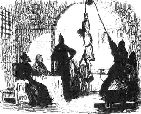

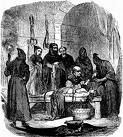


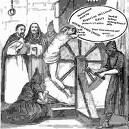
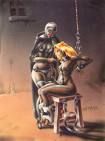
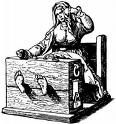




1484 There is a severe plague in Milan this year and next. On Jan. 23 Richard III holds his only Parliament. In the spring the Spanish army under King Ferdinand assembles at Antequera, marches to Alora, raids Coin, Cazabonela, Almjia, Cartama, Pupiana, Alhendrin and the Vega of Malaga before returning to Antequera; on June 10 the Spanish capture Alora; the Spanish raid Vega of Granada in Sept.; some Spanish troops remain to support Boabdil of Granada; on Sept. 20 Spanish troops capture Senetil. On Apr. 9 Richard III's son and heir apparent Edward of Middleham, Prince of Wales (b. 1473) dies suddenly, leaving his daddy without an heir, opening the way for Henry Tudor. On July 5 Richard III's wife Anne Neville grants lands to Queen's College in Cambridge. On July 6 Portuguese navigator Diego Cam discovers and explores the mouth of the Congo River; later Nzinga Myemba, king of Congo (who later takes the name Dom Alfonso) invites the Portuguese to Christianize and Europeanize his kingdom. On July 14 Federico I Gonzaga (b. 1444) dies, and his short, pop-eyed, snub-nosed (but fine soldier) son Francesco II (IV) Gonzaga (1466-1519) becomes marquis of Mantua (until Mar. 29, 1519). On July 22 a 500-man English force led by Duke Alexander of Albany and exiled James, 9th earl of Douglas is defeated by the Scottish royalist army in the Battle of Lochmaben Fair in SW Scotland; Douglas is captured, and Albany flees back to England to plot yet another comeback; meanwhile James III gets a draconian Treasons Act passed. Justice for victims begins with Innocent VIII? Bad time to be a natural redhead? On Aug. 12 Pope (since 1471) Sixtus IV (b. 1414) dies after issuing a bull allowing local bishops to give the bodies of executed criminals and unidentified corpses to physicians and artists for dissection, allowing Vesalius et al. to advance the science of anatomy, and on Aug. 29 Giovanni Battista Cibo (Cybo) is elected Pope (#213) Innocent VIII (1432-92), issuing a fruitless call for yet another Crusade against the Ottomans; the Spanish Inquisition (established Nov. 1, 1478) gets off to a roaring start under joint church-state direction after never-doubting Tomas (Tomás) de Torquemada (1420-98) (the original Punisher?), prior of a Dominican monastery in Segovia persuades Ferdinand II and Isabella I to get Pope Innocent VIII to appoint the Holy Office of the Inquisition, with himself as grand inquisitor for Castile and Aragon in 1487, with the Mission: Imposible of rooting out heresy among converted Jews, where his wanton torqued-up mad (sexually-gratifying?) (the Catholic teaching on sexuality hits the fan?) torture of his 2K victims by 1498 is later uncovered (3 cents. late) by the Spanish Inquisition's gen. secy. (1789-) Juan Antonio Llorente (1756-1823) and Spanish Jesuit historian Juan de Mariana (1536-1624) from an examination of the archives, and spawns tons of gory horror lit.; unlike the original Rome-based Catholic Inquisition (est. 1231), the Spanish Inquisitors are appointed by the sovereigns, and are free of responsibility to the Church, giving them a 007 license to build and operate fun B&D dens, and they end up executing up to 30K during the next 3.5 cents. (2 per week avg.), incl. whole families and towns for offenses such as heresy, freethinking, seduction, smuggling, impersonation, and usury, freely torturing witnesses as well as defendants - zoom zoom zoom? On Sept. 14 Richard III of England concludes a 3-year truce with Scotland. On Sept. 15 Spanish Inquisitor (since 1483) Pedro de Arbues (Arbués) (b. 1441) (known for forcibly converting Jews) is assaulted while praying in the cathedral in Saragossa while wearing a helmet and chain mail; after he dies on Sept. 17, his assassination is blamed on the Jews, causing nine to be executed, two to commit suicide, 13 to be burned at the stake, and four more to be punished for complicity, after which he ends up canonized as a saint by Pope Pius IX in 1867 with the soundbyte "The divine wisdom has arranged that in these sad days, when Jews help the enemies of the Church with their books and money, this decree of sanctity has been brought to fulfillment"; meanwhile Tomas de Torquemada's little ole Inquisition is pumped up, and on Dec. 5 new Pope Innocent VIII issues the bull Summis Desiderantes against witchcraft and sorcery, and orders the Inquisition, led by German theology profs. Heinrich Kramer (1430-1505) and Jacob Sprenger (1436-94) to begin hunting heretics and witches in Germany. In Nov. Charles VIII of France agrees to support the claim of Henry Tudor, earl of Richmond to the British throne and grants funds for his army; a rebellion against Charles VIII is joined by Francis II, duke of Brittany. The Ottomans capture the strategic Moldovan Black Sea ports of Kilia (Chilia) and Akkerman (Cetatea Alba) from Stephen III the Great of Moldova, incorporating the area under the name Budjak ("corner", "triangle"), and expanding up between the Prut River to the W, Danube River, and Black Sea to the S, and Dniester River to the N and E, giving them mastery of the Black Sea as well as control of the trade, and making Moldavia a landlocked principality; the Turkish triangle becomes known as Bessarabia after the Basarab dynasty of Wallachia; Poland and Lithuania become vulnerable to Tartar attacks. Cetinje, near Mt. Lovcen (Black Mountain, from which Montenegro gets its name) becomes the Orthodox Serb capital of mountainous Montenegro under Prince Ivo the Black, which continues to fend off attacks by Muslim Turks. Ottoman-free Otranto passes to the Venetians. Zakynthos Island, 3rd largest of the Ionian Islands (named after the son of legendary Arcadian chief Dardanus) is occupied by the Venetians (until 1797), who nickname it "the Flower of the Levant". Richard III reforms law, trade, and tax collection, and stinks himself up by executing "a poore gentleman called Collingborne for making a small rime of three of his councellors, Lord Louell, Sir Richard Ratcliffe and Sir William Catesbi: The Cat, the Rat, and Louell our dog, Rule all England under an hog. Meaning by the hog, the wild boare, which was the Kings cognisance [coat of arms]." (Holinshed Chronicles III.746, 1586). Joao II of Portugal appoints a commission of mathematicians to produce tables of latitude for seamen. Austria forms its first cuirassier units (mounted cavalry with cuirass breastplate armor and firearms). The first sugar mill begins operation in Gran Canaria, Canary Islands. Nonfiction: William Caxton (1422-92) (tr.), Aesop's Fables (Mar. 26). Joannes de Tinctoris (1436-1511), De Inventione et Usu Musicae. Art: Albrecht Durer (1471-1528), Self-Portrait. Andrea Mantegna (1431-1506), The Triumphs of Caesar (1484-92) (Mantua); the fullest expression of Italian Renaissance art? Pinturicchio of Perugia begins painting Frescoes in the Chapels of Santa Maria del Popolo in Rome (until 1492). Leonardo da Vinci (1452-1519), Cecilia Gallerani; mistress of his patron Lodovico Sforza; she cradles his heraldic figure the ermine as a symbol of her virtue? Births: Swiss humanist Protestant REformation leader Ulrich (Huldrych) (Huldreich) Zwingli (d. 1531) on Jan. 1 in Wildaus, St. Gallen; his doctrine is that the body of Christ doesn't do a Svengali (Zwingli?) act in the Eucharist but that the ceremony is merely commemorative. German Protestant leader George Spalatin (Georg Burkhardt) (d. 1545) on Jan. 17 in Spalt (near Nuremberg); known for translating the works of Martin Luther. German Hohenzollern prince-elector #5 Brandenburg (1499-1535) (Roman Catholic) Joachim I Nestor (d. 1535) on Feb. 21 in Colln; eldest son of John II Cicero (1455-99); brother of Archbishop Albert; father of Joachim II Hector (1505-71). German Protestant margrave of Brandenburg-Ansbach (1536-43) George Hohenzollern (the Pious) (d. 1543) on Mar. 4 in Ansbach; son of Frederick I the Elder (1460-1536) and Sophie Jagiello (daughter of Casimir IV of Poland); brother of Margrave Casimir of Bayreuth (1481-1527) and Duke Albert of Prussia (1490-1568). Italian architect Antonio da Sangallo the Younger (Cordiani) (d. 1536) on Apr. 12 in Florence; nephew of Giuliano da Sangallo (1443-1516). Italian physician and classical scholar (Aristotle expert) Julius Caesar Scaliger (d. 1558) on Apr. 23 in Rocca di Riva, Sermione; father of Joseph Justus Scaliger (1540-1609); soldier for his kinsman HRE Maximilian I from 1496-1514, then studies medicine in Bologne and eventually moves to Agen, France where he becomes the most learned man of his time, until his own son bests him; the scholarly Scaliger family has a cool castle in Sermione (Sirmio) in N Italy at the S end of Lago Di Garda, Italy's largest lake. Spanish Dominican bishop missionary-historian and crusader for social justice ("Apostle of the Indians") Bartolome (Bartolomé) de Las Casas (d. 1566) on Aug. 24 in Seville; emigrates to Hispanola in 1502. Swiss humanist reformer Joachim Vadian (von Watt) (d. 1551) on Nov. 29 in St. Gallen; friend of Huldrych Zwingli. Portuguese (Spanish) explorer Diego Garcia de Moguer (d. 1544) (b. 1496?) in Moguer, Spain (Lisbon, Portugal?). Danish peasant rebellion leader Capt. Klemen Anderson "Skipper" Clement (d. 1536) in Vendysyssel, North Jutland. English soldier Charles Brandon, 1st Duke of Suffolk (d. 1545); son of Sir William Brandon (1426-85); husband of Mary Rose Tudor (1496-1533) (sister of Henry VIII). German "Trinity and Mystic Pieta" painter Hans Baldung Grien (Grün) ("green") (d. 1545) in Schwabisch Gmund. Icelandic Roman Catholic bishop (last) Jon Arason (d. 1550) in Gryta. Deaths: Ottoman historian Ashikpashazade (b. 1400); leaves Tevarih-i Al-i Osman (Histories of the House of Osman) - a long string of #1 hits on the Muslim pop charts? Scottish Rosslyn Chapel builder William Sinclair, 1st earl of Caithness (b. 1410). Italian anatomist Arculanus (b. 1412). Italian pope (1471-84) Sixtus IV (b. 1414) on Aug. 12 in Rome. Italian sculptor Mino da Fiesole (b. 1429) on July 11. Florentine poet Luigi Pulci (b. 1432) on Nov. 11 in Padua; leaves the epic poem Morgante Maggiore, about a giant who is converted to Christianity by the knight Orlando. Spanish inquisitor St. Pedro de Arbues (b. 1441) on Sept. 17 in Saragossa (assassinated). Italian marquis of Mantua (1478-84) Federico I Gonzaga (b. 1444) on July 14 in Mantua. Polish-Lithuanian prince St. Casimor Jagiellon (b. 1458) on Mar. 4 in Hrodna, Belarus (TB); canonized in 1522. English prince of Wales (1483-4) Edward Plantagenet of Middleham (b. 1473) on Apr. 9 (Mar. 31?); buried in the parish church of Sheriff Hutton, becoming the first prince of Wales buried in a parish church (until ?).


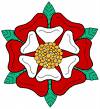
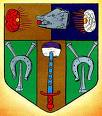
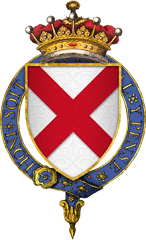







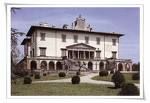
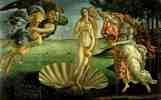
1485 Early in the year Al-Zagal drives Muhammad XII from Almeria, and he flees to King Ferdinand in Cordoba; on Apr. 27 Ferdinand takes Coin, followed on Apr. 28 by Cartama; meanwhile the garrison of Ronda raids Medina Sidonia but returns to find its city sieged by King Ferdinand in early May; Abu Hasan of Granada dies, and Al-Zagal becomes emir in late May, defeating a Christian foraging party from Alhama on his way to Granada; three groups of Spanish troops march toward Moclin in late Aug., and Al-Zagal ambushes and defeats the 1st group, which is rescued by the 2nd group in early Sept.; Al-Zagal enters Moclin, after which the 3rd group under Ferdinand joins the other two and they take the castles of Cimbil and Albahar on Sept. 23; the Spanish of Alhama take the castle of Zalea in Sept. It's handsome Richmond vs. ugly hunchback cripple Richard, kicking his butt and getting the babe? Sounds like a setup? On Mar. 16 Richard III's queen Anne Neville (b. 1456) one year after the death of their only son Edward (poisoned by Richard III so that he can scandalously marry his niece Elizabeth of York, daughter of the late Edward IV before Henry Tudor can get her?), and Richard III names his nephew John de la Pole, 1st Earl of Lincoln (1462-87) as his heir; meanwhile Henry Tudor, earl of Richmond, who had been waiting in the wings in refuge in Brittany for many years, secures troops and money from Charles VIII of France and duke Francis II of Brittany (only 400 of his 2K troops are English), and sails from Harfleur on July 31-Aug. 1 with Edward Courtenay and Edward Woodville, then reaches Mill Bay (Nanjizal) (near Land's End Walking, Cornwall) on Aug. 2, and lands at Milford Haven in Pembrokshire, SW Wale) on Aug. 7 (evening), reciting Psalm 26:1 ("Judge me Lord") and kissing the sand, the news causing widespread defections among Richard's supporters, incl. the Stanley family; after Sir William Stanley (1435-95) allows him passage across N Wales, and Sir Gilbert Talbot of Grafton (1452-1518) and 500 of Lord Shrewsbury's retainers from Shropshire join with him, and he gathers his forces at Lichfield and threatens to cut Richard III off from London, on Aug. 17 he marches to Tamworth, where he is joined by John Savage and his Welsh levies, staying overnight at the Three Tuns in Tamworth; on Aug. 20 he joins up with Lord Stanley and his brother William Stanley in Atherstone, and after being guided by John Hardwick stays overnight on Aug. 21-22 at White Moors on the Tweed River; meanwhile Richard III, who dispatched Francis Lovell, 1st Viscount Lovell (1456-89) and his fleet to guard the English Channel, and left his HQ at Nottingham Castle to muster his army on Aug. 16 at the Nottingham marketplace, is greeted by the pop. of Leicester on Aug. 17, stays overnight at the Blue Boar, then reaches Elmesthorpe on Aug. 18, followed by Bosworth on Aug. 22, where he declares "I will not budge a foot; I will die king of England." In Mar. Vladislav II of Bohemia loses his power to his nobles in the Kutna Hora Pact. In the spring Duke Alexander Stewart of Albany (b. 1454) leads another small English force into Scotland, is captured and imprisoned in Edinburgh Castle, then escapes to France, where he is killed in a tournament in Paris with the Duke of Orleans by a splinter from his lance on Aug. 7. On June 1 Matthew Corvinus of Hungary captures Vienna from HRE Frederick III, and makes it his capital. On Aug. 5-7 the first outbreak of English sweating sickness (English sweate) in England begins; really hantavirus? On Aug. 22 after Sir Simon Digby (-1519) of Coleshill deserts Richard III and gives Henry Tudor details of his position, the Wars of the Roses (begun 1455) between the White Rose (Rosa Alba) of York and the Red Rose (Apothecary's Rose) (Old Red Damask) (Rose of Provins) of Lancaster (White Peppermint Patty of York and Bloody Red Rose of Lancaster?) ends after 32 years and 26 days with the doglike death of Yorkist hunchback cripple king (since 1483) Richard III (Gloucester) (b. 1452) at the Battle of Bosworth (Redemore) (Dadlington) Field 2 mi. SW of Albion Hill in Leicestershire near the market town of Market Bosworth 12 mi. W of Leicester after his horse loses a nail in his shoe in a bog and goes down (with lame Richard crying "A horse! A horse! My kingdom for a horse!", according to William Shakespeare's Richard III, 5.4.7); Ben Franklin in his "Poor Richard's Almanac" of 1758 issues the soundbyte "For want of a Nail the Shoe was lost; for want of a Shoe the Horse was lost; and for want of a Horse the Rider was lost, being overtaken and slain by the Enemy, all for want of Care about a Horse-shoe Nail"; Richmond's army numbers 5K vs. 15K for Richard; actually, Richard's army attacks first, but Henry's army forms itself into a V shape, then Richard leads a charge of his heavily-armed household knights and comes to within an inch of Henry, but Henry's foot soldiers defend him and run him through, and Richard III becomes the last English king to die on the battlefield, and the first since Harold II at the Battle of Hastings in 1066; only 100 of Henry's vs. several hundred of Richard's soldiers are lost, because Yorkist turncoat Sir William Stanley leads his troops in an attack on Richard as he closes in on Henry, then, after Richard falls (he kills him?), finds the royal crown (which fell from his helmet) on a er, rose bush, and places it on Tudor's head, proclaiming him king and stopping the hostilities?; Henry's standard bearer William Brandon is killed, along with Richard's men John Howard and Robert Brackenbury; Thomas Howard is captured and imprisoned in the Tower of London (until 1488), along with Yorkist heir (the last Pantagenet) Earl Edward of Clarence (Warwick). On Aug. 24 after being displayed for two days, the body of Richard III is buried in Greyfriars Church in Leicester; he is later immortalized by Sir Thomas More in his 1548 history, even though his body is actually cast out of the grave to become dog food. On Sept. 12 the Muscovites take Tver. On Oct. 30 after securing parliamentary ratification, Henry Tudor is crowned Henry VII (1457-1509) (Britain's 39th monarch) (until Apr. 21, 1509) in Westminster Abbey by Canterbury archbishop (since 1454) cardinal Thomas Bourchier (1404-86) (same dude who crowned Richard III in 1483), founding the House of Tudor (two-door, or two-tone?), becoming the first (only) British king to be crowned on the field of battle first; next Jan. 17 the White Rose of York and the Red Rose of Lancaster are united in the combined Red-White Tudor Rose with Henry VII's marriage to Elizabeth of York, daughter of Edward IV (who is declared legitimate) (also performed by Thomas Bourchier, who soon dies one pooped-out prelate) (a little too nicely timed, to let Henry VII's longtime ally the bishop of Ely have his job?); the pesky Welsh are appeased by the promise of assimilation on an equal basis; Henry brings French ideas of royalty with him, and Richard's death marks the end of the feudal period in England along with the Plantagenet line, since the nobles are too weak now to challenge the Tudors?; on Oct. 27 Thomas Stanley is created 1st earl of Derby for his services. On Nov. 7 the English Parliament convenes in London, with the Commons having 296 members representing 37 counties and 111 boroughs. On Nov. 11 the Treaty (Partition) of Leipzig causes the possessions of the House of Wettin ruling family of Saxony to be redistributed, with one part (Meissen) becoming a duchy with capital at Dresden under Duke Albert III "the Bold" of Saxony (1443-1500), who founds the Albertine branch of the Wettin family, ruling ducal Saxony, and the rest remaining an electorate under his older brother Elector Ernest of Saxony (1441-86), with capital at Wittenberg, who founds the Ernestine branch of the Wettin family; Ernst also receives an area around Wittenberg incl. S Thuringia, the Vogtland, and parts of Pleissnerland; the partition prevents the formation of a C German power, allowing Brandenburg-Prussia to rise. On Nov. 16 the Ottomans invade Moldavia again, and are defeated by Stephen III the Great at the Battle of Catlabuga Lake. On Dec. 16 Jasper Tudor is created the 3rd duke of Bedford, and the De Vere family (named after Ver in Lower Normandy, France) is restored to their title of earl of Oxford (insuring the future of Shakespeare's plays?); Sir William Stanley is appointed lord chamberlain; in Dec. Elizabeth Woodville is stripped of her lands and exiled; Sir Richard Howard, who dies at Bosworth Field has his titles attained, along with his son Thomas Howard, who is wounded and imprisoned until 1489; although Ireland supported the Yorkist cause, Henry VII leaves Gerald FitzGerald, 8th Earl of Kildare ("Garret the Great") (1456-1513) of the powerful Geraldine family as viceroy (1477-94, 1496-1513), Ireland's premier peer. Archduke Maximilian of Austria secures the release of his son Philip I from captivity in Ghent, but does not establish control over the Low Countries until 1493. King Ferdinand I Ferrante of Naples massacres his nobles after they had surrendered on terms of amnesty. Marco Barbarigo (1413-86) becomes doge #73 of Venice (until 1486). Duke Charles I the Warrior of Savoy inherits the titles of king of Cyprus, Jerusalem and Armenia after his father's first cousin (uncle's widow), childless queen Charlotte de Lusignan of Cyprus (1442-87) (king of John II of Cyprus), who had been exiled from her inherited kingdom in 1463 surrenders her rights to him; the kingdom itself is held by the repub. of Venice. The First Ottoman-Mamluk War (ends 1491) begins over the buffer principality of Dulkadir (Dulkadiroglu) in S Anatolia, ending in inconclusive campaigns in S Anatolia and Ottoman failure to take the Cilician towns of Adana and Tarsus. Portuguese sailors first appear in Benin. Indian environmentalist saint Guru Jambheshwar (1451-) founds the Bishnois ("Twenty-niner") religion that considers trees and animals sacred, and protects them. By this year English justices of the peace have absorbed most of the functions of the sheriffs, and are chosen from the local gentry under royal commission, constituting an amateur admin. body for local govt. until the 19th cent. The term "House of Lords" comes into use in England during Henry VIII's reign. The Yeoman Warders (Yeomen of the Guard) (Beefeaters) are founded by new king Henry VII to guard the Tower of London and act as his bodyguard, going on to get scarlet-gold dress uniforms in 1552 and accompany the king into battle until 1743; in 1848 civilians are prohibited from purchasing appointments, and only army and marine veterans can serve; plain jane Queen Victoria gives them blue undress uniforms in 1858. The Kronen Brewery in the Hanseatic town of Luneburg (Lüneburg), Lower Saxony, Germany (31 mi. SE of Hamburg) is one of 80 brewers in town. Architecture: Tudor Placentia Palace in Greenwich is begun by Henry VII. Villa Medici in Poggio a Caiano, the first great Renaissance villa is begun for Lorenzo de' Medici by Giuliano da Sangallo (1443-1516) (who was named for restoring an Augustinian monastery outside the Florentine gate of San Gallo). Nonfiction: Leon Battista Alberti (1404-72), De Re Aedificatora (posth.). Johann Wonnecke of Kaub (1430-1504), Gart der Gesundheit; a herbal pub. for Mainz canon Bernhard von Breidenbach (1440-97) containing 382 plants, 28 minerals, and 435 chapters. Art: Giovanni Bellini (1428-1516), Madonna and Child with Saints (1485-90). Sandro Botticelli (1445-1510), Venus and Mars; The Birth of Venus (1485-6); modeled by Simonetta Vespucci. Domenico Ghirlandaio (1449-94), The Adoration of the Shepherds. Novels: England invents its own Mystery Man Island Christ, complete with its own gospel? Sir Thomas Malory (1405-71), Le Morte d'Arthur (Le Morte Arthure) (The Book of King Arthur and His Noble Knights of the Round Table) (21 vols.) (posth.); printed by William Caxton, becoming the first book in poetic prose, and the first novel in the English language; written while rotting in prison on trumped-up charges after calling for reform during the Wars of the Roses; based on an anon. early 13th cent. La Mort le Roi Artu (1237); Malory puts bits of his own life in Arthur's tale; after Arthur is mortally wounded, Sir Bedivere throws Excalibur in the lake so that it will not see him dead, and "there came an arm and an hand [the Lady of the Lake] above the water and met it, and caught it, and so shook it thrice and brandished, and then vanished away the hand with the sword in the water"; Arthur then goes to the "Vale of Avilion (Avalon), to heal me of my grievous wound"; "Yet some men say in many parts of England that King Arthur is not dead, but taken by the will of our Lord Jesu into another place; and men say that he shall come again, and he shall win the holy cross"; "Here lies Arthur, once and future king" becomes the dream of all English kings, who want to claim that they're him, whether or not they are of Celtic heritage?; the Winchester Manuscript is unearthed in 1934 - there's a kind of hush all over the world, or, sentimental fool am I, but the melody keeps haunting me? Births: German Lutheran reformer Johannes Bugenhagen (Doctor Pomeranus) (d. 1558) on June 24 in Wollin, E Pomerania. Italian (Venetian) geographer Giambattista (Giovanni Battista) Ramusio (d. 1557) on July 20 in Treviso. English queen (1509-33) Catherine of Aragon (d. 1536) (baptismal name Catalina) on Dec. 16 in Laredo Palace, Alcala de Henares; 4th daughter of Ferdinand II of Aragon (1452-1516) and Isabella I of Castile (1451-1504); 1st wife (1509-33) of Henry VIII (1491-1547). Italian navigator (discoverer of New York harbor) Giovanni da Verrazano (Verrazzano) (d. 1527) in Val di Greve (near Florence). English soldier-statesman Thomas Cromwell (OE "winding stream"), 1st Earl of Essex (d. 1540) in Putney (near London); born of humble parentage; uncle of Oliver Cromwell's great-grandfather Richard Williams, who changes his name to Cromwell; created baron in 1536 and earl in 1540. Italian Renaissance composer Costanzo Festa (d. 1545) near Turin. Spanish conquistador Hernan Cortes (Hernán Cortés) de Monroy y Pizarro, Marquis of the Oaxaca Valley (d. 1547) in Medellin. Italian painter Sebastiano del Piombo (d. 1547). French madrigal composer Philippe Verdelot (Deslouges) (d. 1550). English #1 Protestant preacher-martyr Hugh Latimer (d. 1555) in Thurcaston, Leicestershire. Portuguese poet-dramatist Francisco de Sade Miranda (d. 1558) in Coimbra. French Renaissance composer-priest Clement Janequin (Jannequin) (d. 1559) in Chatelleraut (near Poitiers). Ottoman Greek adm. Dragut (Turgut) Reis (d. 1565) near Bodrum. Italian humanist bishop-poet Marcus Hieronymus (Marco Girolamo) Vida (d. 1566) in Cremona. Deaths: Tibetan saint Thangto Gyalpo (b. 1385) (d. 1464?). Welsh bard Dafydd Nanmor (b. 1420). English soldier John Howard, 1st duke of Norfolk (b. 1430) on Aug. 22 in Bosworth Field (KIA). German humanist scholar Rudolf Agricola (b. 1444) on Oct. 27/28 in Heidelberg; gets sick on a journey to Rome as ambassador of John of Dahlberg, bishop of Worms. English king (1483-5) Richard III (b. 1452) on Aug. 22 in Bosworth Field (KIA); in 2013 his remains are discovered under a parking lot in Leicester at the site of Grey Friars Church; he is found to be suffering with roundworms. English queen (1483-5) Anne Neville (b. 1456) on Mar. 16 in Westminster (TB).






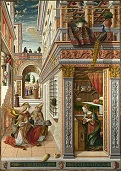
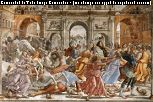
1486 On Jan. 18 Richmond, er, Henry VII marries Elizabeth of York, eldest daughter of Elizabeth Woodville and granddaughter of Duke Richard of York, uniting the English houses of York and Lancaster - tonight all over the world you can hear the sound of lalala what? Do you have any hobbies or interests, such as reading or sports? On Feb. 15 Archduke Maximilian of Austria, son of AEIOU Frederick III (d. 1493) is elected king Maximilian I (1459-1519) of the Romans in Frankfurt am Main, and his daddy resigns and settles in Linz, devoting himself to the study of the pseudo-sciences while remaining HRE, a job he delegates (good time to be running a metaphysical supply store?); on Apr. 9 the journey to Rome being too risky to be crowned by the pope, Maximilian I is crowned in Aachen, after which he joins with Brittany against France; the Hapsburgs control the HRE until 1806. On Mar. 11 Brandenburg prince-elector #3 (since 1470) Albert II Achilles (b. 1414) dies, and the Hohenzollern Franconian possessions pass to his younger brothers Frederick I (1460-1536) and Siegmund (1468-95), while the prince-electorship of Brandenburg passes to his eldest son John II Cicero (1455-99) (until Jan. 8, 1499). On Mar. 30 Thomas Bourchier (b. 1404) dies after marrying Henry VIII and Elizabeth of York, and on Oct. 6 John Morton (1420-1500) (mentor of Sir Thomas More, who was a page in his house) becomes archbishop of Canterbury (until 1500). In Mar. Stephen III of Moldavia defeats the Ottomans again at the Battle of Scheia on the Siret River, and concludes a treaty with Sultan Beyazid II recognizing Moldavian autonomy on the condition of an annual tribute. The first entrepreneur giving a hotel pitch to a potential angel? On May 1 Christopher Columbus meets with Queen Isabella to try and convince her to fund his expedition to the West Indies; he tempts her with a pledge to use any profits to finance the recapture of Jerusalem from the Muslims, after which the Great Temple would be rebuilt - and Christ finally return? On July 16 Henry VII finally announces the murder of the princes in the Tower by their dead uncle Richard; the delay makes some suspect that it was he not Richard who had them murdered, since the only way he could get the crown was to marry Elizabeth, while declaring her legitimate, but that would make the princes legitimate also, barring him from the crown - but the hunchback cripple is always the bad guy, right? Marco Barbarigo (b. 1413) dies, and his brother Agostino Barbarigo (1420-1501) becomes doge #74 of Venice (until 1501). Tizoc dies (poisoned?), and his brother Ahuitzotl (-1502) becomes king #8 of Tenochtitlan in Mexico (until 1502), quelling a rebellion of the Matlatzincans of the Toluca Valley, then going on to double the size of the Aztec empire after conquering the Mixtecs, Zapotecs et al. as far as W Guatemala. Italian Renaissance wunderkind philosopher Count Giovanni Pico della Mirandola (1463-94) gets in trouble when he settles in Rome and pub. Oration on the Dignity of Man (De Hominis Dignitate) ("the Manifesto of the Renaissance"), in which he proposes 900 theses and offers to defend them against all comers, and Pope Innocent VIII deems 13 of them dealing with cabalistic magic heretical, esp. "A mortal sin of finite duration is not deserving of eternal but only of temporal punishment", and forbids him to discuss them; the oration becomes a key Renaissance humanist text and helps launch the Hermetic Rev.; "Human vocation is a mystical vocation that has to be realized following a three stage way, which comprehends necessarily moral transformation, intellectual research and final perfection in the identity with the absolute reality. This paradigm is universal, because it can be retraced in every tradition" - if only he had said 800 or 850? Il Perugino moves to Florence (until 1499). After pumping up the silver mines in Tirol, Archduke Sigismund of Austria, AKA der Munzreiche (Ger. "rich in coin") begins minting the guldengroschen, Europe's first heavy silver coin, which later becomes the thaler, spawning many Euro coin denominations; when the Spanish begin pumping up their silver mines in Am. in the early 16th cent., Europe becomes a land of heavy silver coins? - we don't have any silverware, all we have is this? Nonfiction: Anon., St. Albans Book; earliest example of color block printing in England; starts the fad for "nouns of multitude", e.g., plague of locusts, pride of lions, litter of pups. John Alcock (1430-1500), Sponsage of a Virgin to Christ. Bernhard von Breydenbach, Map of the Holy Land. Conradus Celtis (Conrad Celtes) (1459-1508), Ars Versificandi et Carminum (The Art of Writing Verses and Poems). Follow your heart? Without love where would you be right now? Keinrich Kramer (1430-1505) and James Sprenger (1436-94), Malleus Maleficarum (Hammer of Witches); approved by the Vatican, even though the U. of Cologne condemns it; the #1 guidebook for Inquisitors; incl. instructions to remove hair from every part of the body "even... the most secret parts" to search for hidden objects and the Devil's mark (Satan's nipple), and for due process requires a witch to confess before being condemned to death, authorizing torture to obtain a first confession, followed by another "free and open confession"; condemned witches are to be handed over to the civil authorities swiftly for execution, and if they renounce Satan they get treated with quick easy strangulation before the pyres are lit; the Church and lay authorities then get to split the heretic's property - see you in court? Giovanni Pico della Mirandola (1463-94), Conclusiones Cabbalisticae (72 Conclusions on the Kabbalah); #14 argues that Jesus' real name Yeheshuah consists of the Tetragrammaton YHWH plus the Hebrew leter shin, showing the descent of the Holy Spirit into the fourfold realm of matter, i.e., the incarnation of God, and makes the unpronounceable YHWH pronounceable, giving the new name by which miracles can be performed. Antoine de la Sale (1385-1462), Cent Nouvelles Nouvelles. Art: Sandro Botticelli (1445-1510), Madonna of the Pomegranate. Carlo Crivelli (1430-95), The Annunciation, with St. Emidius. Domenico Ghirlandaio (1449-94), The Massacre of the Innocents (1486-90) (Santa Maria Novella, Florence). Births: German Renaissance composer Martin Agricola (Sohr) (Sore) (d. 1556) on Jan. 6 in Schwiebus, Lower Selesia. Italian sculptor-architect Jacopo d'Antonio Sansovino (Tatti) (d. 1570) on July 2 in Florence; student of Andrea Sansovino. Italian painter Andrea del Sarto (Andrea Domenico d'Agnolo di Francesco) (d. 1531) on July 16 in Florence. German diplomat-historian Baron Sigismund (Siegmund) von Herberstein (d. 1566) on Aug. 23 in Wippach, Carniola (Vipava, Slovenia); expert on Russia; educated at the U. of Vienna. German occult feminist scholar Henricus (Heinrich) Cornelius Agrippa von Nettesheim (d. 1535) on Sept. 14 in Nettesheim (near Cologne); educated at the U. of Cologne; student of Johannes Trithemius (1462-1516). English prince of Wales (redhead) Arthur Tudor (d. 1502) on Sept. 19/20 in Winchester, Hampshire; eldest son of Henry VII (1457-1509) and Elizabeth of York (daughter of Edward IV); named after Malory's "Le Morte d'Arthur", pub. last year, with Henry VII claiming descent back to Cadwallader, also claiming that Winchester is Camelot; godfathers are John de Vere, 13th earl of Oxford and John Stanley, 1st earl of Derby; godmother is Elizabeth Woodville; born 1 mo. premature? Italian duke of Savoy (1504-53) Charles III (d. 1553) on Oct. 10; younger son of Philip the Landless (1438-97) and Claudine de Brosse, whose family unsuccessfully claims the duchy of Brittany; first cousin of Charles I of Savoy; husband of Beatrice of Portugal (1504-38) (daughter of Manuel I). Spanish conquistador Pedro de Alvarado (d. 1541) in Badajoz. German Protestant Reformation leader Andreas Rudolph Bodenstein von Karlstadt (Carlstadt) (AKA Brother Andrew) (d. 1541) in Karlstadt, Franconia; educated at the U. of Wittenberg. Swiss composer Ludwig Senfl (d. 1542). German Roman Catholic theologian and mystic (opponent of Lutheranism) Johann Maier (Mayer) von Eck (d. 1543) in Eck, Swabia (S Germany); educated at the U. of Heidelberg, U. of Tubingen, and U. of Cologne; prof. of theology at Ingolstadt (1510-40). Indian Suri emperor #1 (1538-45) Sher Shah Suri (d. 1545) in Sasaram (modern-day Bihar). Italian Renaissance painter Francesco Torbido (d. 1562). Deaths: English lord chancellor (1456-60) William Waynflete (b. 1398) on Aug. 11 in Bishop's Waltham, Hampshire; founder of Magdalen College in Oxford. English archbishop of Canterbury (1454-86) cardinal Thomas Bourchier (b. 1404) on Mar. 30 near Sevenoaks. German prince-elector of Brandenburg (1470-86) Albert II Achilles (b. 1414) on Mar. 11 in Frankfurt am Main. Japanese samurai Ota Dokan (b. 1432) on Aug. 25. German elector Ernst of Saxony (b. 1441) on Aug. 26 in Colditz (fell from a horse). Portuguese explorer Diogo Cao (b. 1452). Scottish queen Margaret of Denmark (b. 1456) on July 14 in Stirling Castle.
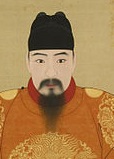

1487 In Mar. Hapsburg Archduke Sigismund of Austria "the Rich in Coin" declares war on the Repub. of Venice in order to seize its silver mines in the Valsugana Valley, beginning the War of Rovereto in N Italy; in Apr. Sigismund imprisons 130 Venetian merchants en route to the fair in Bolzano, confiscating their goods, after which his troops from Tirol storm the Pass of Calliano, then siege Rovereto Castle, becoming one of the first uses of the massive bombard cannon; the war fizzles out by fall, causing the pop. of Tirol to begin turning against him; on Aug. 10 the Battle of Calliano in Trentino, Italy is a decisive V for the bishopric of Trent and the county of Tyrol over Venice, becoming the first deployment of Landsknechte troops, German (Tyrolean or Swabian) troops trained the Swiss way. On May 4 a Yorkist fleet carrying Richard III's disgruntled nephew and heir John de la Pole arrives in Dublin, soon recruiting 4.5K Irish mercenaries with the help of lord chancellor Sir Thomas Fitzgerald; on May 24 teenie Yorkist imposter Lambert Simnel (1475-1535) (claiming to be Earl Edward of Warwick, son of Duke George of Clarence, who is actually imprisoned in the Tower of London) is crowned as king Edward VI of England in Christchurch Cathedral, Dublin, with de la Pole using him as his front, with aid from Frances Lovell, 1st viscount Lovell, landing in Lancashire on June 4, beefing up to 8K men, then covering 200 mi. in 5 days via forced marches, defeating 400 Lancastrians on June 10 (night) at the Battle of Bramham Moor near Tadcaster, then staging a diversionary attack on June 12 at Bootham Bar in York in order to take Henry VII's northern army under Henry Percy, earl of Northumberland out of the action; too bad, the Lancastrian cavalry under Lord Scales slows down the main Yorkist army for 3 days in the Sherwood Forest, allowing Henry VII to receive reinforcements under Lord Strange on June 14; on June 16 the Battle of Stoke Field (Stoke-on-Trent) outside Newark is a V for Henry VII's 12K troops over de la Pole's 8K men after the Irish mercenaries, who lack body armor fall in large numbers, with 4K casualties for de la Pole vs. 3K casualties for Henry VIII; de la Pole is KIA, along with all of the Yorkist cmdrs.; Simnel is captured, pardoned, and given a job in the king's kitchens - Hell's Kitchen? On July 29 Lorenzo de' Medici's wife Clarice dies suddenly of TB at 34 - Hannibal the Cannibal mourns? In early Aug. Portuguese explorer Bartholomeu Dias (b. 1450) leaves Lisbon to sail down the coast of Africa. On Sept. 9 emperor (since Feb. 28, 1464) Chenghua (b. 1447) dies, and on Sept. 22 his son becomes Hongzhi ("great government") (Zhu Youcheng) (1470-1505), Ming emperor #9 of China (until June 8, 1505), becoming an ascetic with only one wife and no concubines, who lets affairs of state slide, which is later called the Hongzhi Silver Age. On Nov. 17 Pope Innocent VIII issues a bull prescribing universal censorship of books, especially irreligious ones. The Spanish reconquer Malaga from the Arabs, and the churchbuilders set to work. Duke Albert of Saxony leads an expedition against Matthias Corvinus of Hungary, but he gives up after the HRE fails to support him. Bavarian duke (1465-1508) Albert (Albrecht) IV "the Wise" (1447-1508) requires all brewers in Munich to take an oath of allegiance to the 1447 beer purity law, and introduces price controls (a one liter beer costs 1 silver pfennig in winter, 2 in summer). Christopher Columbus goes before the Council of Salamanca in an unsuccessful attempt to convince Spanish king Ferdinand II's council to support his proposed voyage to find a new route to India, but they do grant him a living allowance. Henry VII of England establishes the Court of Star Chamber, showing that he means to be an autocratic king. Joao II of Portugal sends an overland expedition led by Pedro (Pero) da Covilha (1460-1527) to India and the E coast of Africa - keep trying and you might get lucky? 21-y.-o. Desiderius Erasmus (b. 1466), student at the Augustinian Steyn Monastery near Gouda begins writing love letters to fellow monk Servatius Rogerius, whom he calls "half my soul", with the soundbyte "I have wooed you both unhappily and relentlessly"; he ends up taking priestly vows to eat, but never works as a priest, and spends his life attacking monasticism. The Cheng Hua Period of Chinese Porcelain (begun 1406) ends. Architecture: The Aztecs are the Nazis of America, complete with mass extermination centers and peop-eating cannibal priests? Aztec emperor Ahuitzotl dedicates the 114-step Great Temple (Templo Mayor) of Tenochtitlan by sacrificing four 2-mi.-long lines of people (40K-80K total) (captured enemies?) from sunup to sundown for four straight days; "May he savor the fragrance, the sweetness of death by the obsidian blade" chant the skull mask-wearing priests, who give a swift and merciful death, cutting out the beating heart (yollotl), then decapitating and chopping up the lucky victim and cooking a bowl of yummy sacred tlacatlaolli stew containing dried maize and spices, and partying hearty; meanwhile, the victim's "flowery" blood feeds the gods, who require payback for having sacrificed theirs to make the Earth, and the lucky plucker transforms into an eagle man who ascends into the heavenly company of the Sun? Inventions: Leonardo da Vinci invents the tank, "which will enter the closed ranks of the enemy with their artillery, and no company of soldiers is so great that it will not break through them. And behind these our infantry will be able to follow quite unharmed and without any opposition"; no real tanks are fielded until WWI. On Jan. 30 bell chimes are invented by Christina Petty in ? The modern slide trombone (sacbut) is invented by ?. Art: Leonardo da Vinci (1452-1519), The Vitruvian Man; a study of human proportions based on the statement of 1st cent. B.C.E. Roman architect Marcus Vitruvius Pollio that the "well-shaped man" fits into the perfect shapes of the square and circle, and that the parts of the body are related to one another in whole number ratios - yes, that incl. the johnson; and the missing circumscribing circle is a vagina? Births: Hungarian king (1526-40) John (Janos) Zapolya (Zápolya) (Szapolyai) (d. 1540) on Feb. 2 in Spis Castle; son of Stephen Zapolya, palatine (regent) of Hungary; father of John II Sigismund Zapolya (1540-71). Persian Safavid shah #1 (1502-24) (Shia Muslim) Ismail I (d. 1524) on July 17 in Ardabil. Italian pope (1550-5) Julius III (Giovanni Maria Ciochhi del Monte) (d. 1555) on Sept. 10 in Rome. German celeb Anna Reinhard (d. 1538); wife (1522-) of Ulrich Zwingli. Italian Renaissance painter Bonifazio Veronese (Bonifazio di Pitati) (Bonifazio Veneziano) (d. 1553) in Verona; student of Jacopo Palma; paints a number of religious "Sante Conversazioni" paintings in his early years. German humanist doctor Johannes Gunther (Johannes Winter von Andernach) (d. 1574) in Andernach (ancient Roman city of Antunnacum) (between Bonn and Koblenz on the Rhine River); teacher of Vesalius, Servetus, and Rondelet in Paris. Deaths: Italian clergyman Antonio Bettini (b. 1396) on Oct. 22 in Siena. Byzantine humanist scholar John Argyropoulos (b. 1415) on June 26 in Italy. Swiss mystic St. Niklaus von Flue (b. 1417) on Mar. 21 in Sachseln; canonized in 1947 by Pope Pius XII.


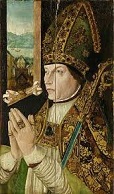




1488 On Jan. 8 Maximilian I of Austria orders the creation of the Royal Netherlands Navy, which grows into one of the world's most powerful naval forces during the Dutch Repub. of 1581-1795. Sounds like a hot night with a high class hooker? On Feb. 4 after reaching Walvis Bay in Dec., discovering the Westerlies and exploring Table Bay at the N end of the Cape Peninsula, then rounding the Horn, becoming the first European to reach the Indian Ocean from the Atlantic Ocean, reaching a record S latitude for a European then turning NE and sailing for 30 days, discovering and mapping discovering Angra Pequena (Port. "small bay") (AKA Angra de Sao Christovao) in modern-day Namibia, Portuguese explorer Bartholomeu (Bartolomeo) Dias (Diaz) (1450-1500) discovers Mossel Bay, then turns back after reaching the mouth of Bushman's River on Mar. 12; in May on his return he discovers the Cape of Good Hope, which he calls the Cabo Tormentoso (Cape of Storms) before returning to Lisbon in Dec.; King John II later renames it in the spirit of Erik the Red to keep his sailors from bolting; he discovers Robben Island in Table Bay in South Africa, then returns to Lisbon in Dec. On Feb. 5 the Flemish pop. of Bruges in Belgium captures HRE Maximilian I after his surprise attack is discovered in advance, and he is forced to g rant the General States a number of concessions; Duke Albert of Saxony is appointed Stattholder of the Netherlands (until 1493), and marches to Bruges and frees him; after Maxy leaves, manly knight Albert stays behind to subdue the rebels in Flanders, Brabant and Holland. On Feb. 28 Korean official Ch'oe Pu (Choe Bu) (1454-1504) shipwrecks in Taizhou, Zhejian in SE China, after which he and his crew are hosted by the Chinese govt., traveling along the Grand Canal to Beijing, then across the Yalu River into Korea, after which he writes the valuable Diary of Ch'oe Pu. The Battle of Burning Sausage? In Feb. super-unpopular Scottish king (since 1460) James III (nice long bobbed hair, cute mouth and nose, nice ass and package?) replaces Colin Campbell, 1st earl of Argyll as chancellor with Aberdeen bishop William Elphinstone (1431-1514), triggering another revolt, this time led by his eldest son Duke James of Rothesay; on June 11 the Battle of Sauchieburn S of Stirling sees James III of Scotland (b. 1460) assassinated in a skirmish by a conspiracy of nobles outraged at his abuses (incl. open homosexuality?), becoming a decisive rebel V; on June 24 15-y.-o. Duke James of Rothesay is crowned James IV (1473-1513) of Scotland at Scone (until Sept. 9, 1513), staying a minor until 1495 so he can complete his education, assisted by learned tutors Archibald Whitelaw (1415-98) (royal secy.) and John Ireland (royal confessor), which incl. lessons in Latin, French, Danish, and Gaelic, after which he learns Italian, Spanish, Flemish, and German, along with the Bible and history, turning him into Scotland's first true Renaissance king, and the last to speak Scottish Gaelic, sending two children to be raised by a mute woman on Inchkeith Island to see if language is learned or innate, running his own alchemy workshop, and attempting to fly from the battlements of Stirling Castle; feeling guilt over his daddy's death, he takes to wearing an iron chain around his waist, adding one new weight to it each year, and makes a yearly pilgrimage to the Shrine of St. Ninian at Whithorn Cathedral in Dumfries and Galloway (where Robert I went for a cure for leprosy in 1329) - the original I've got ten pound balls? On Apr. 1 John II (b. 1426) dies, and his younger brother Charles II (1434-88) (who was elected arbishop of Lyon at age 10 and rose to cardinal) becomes duke of Bourbon, but on Apr. 10 his younger brother Peter II (1438-1503) and his wife Anne of Beaujeu (eldest daughter of Louis XI) expel him by force, and on Apr. 15 make him renounce his claims, after which he croaks on Sept. 13; meanwhile the new duke and duchess of Bourbon add Bourbon-Lancy to their domains in Dec., then trade l'Isle-en-Jordain for Carlades and Murat next June with the Armagnacs. On July 9 Azerbaijan Safavid ruler (since 1460) Sheikh Haydar, son of Junayd and father of Shah Ismail I (b. 1487) is KIA at the Battle of Tabarsaran in Shirvan against White Sheep ruler Ya'qub in alliance with the ruler of Shirvan, and the White Sheep then begin a crackdown on the Safavid Redheads, which only makes them redder, leading his 1-y.-o. son to later plan a final takeover in perfect hair color Persia? On July 28 a French army under Louis II de La Tremoille (Trémoille) (1460-1525) defeats Duke Francis II of Brittany at the Battle of Saint-Aubin du Cormier in Brittany (who suffers 6K casualties), and secures his promise that his 11-y.-o. daughter Anne of Brittany (1477-1514) will marry only with the consent of the French crown; on Sept. 9 Duke Francis II (b. 1433) falls off his horse and dies, making Anne the duchess of Brittany, triggering the Mad War (La Guerre Folle) (ends 1489), and a coalition of Maximilian I of Austria, Henry VII of England and Ferdinand II of Aragon is formed to prevent France from swallowing Brittany. The Swabian League is formed in SW Germany (ends 1534). The African kingdom of Mali falls to Moroccan invaders; the European discovery of a coastal route destroys its Saharan trade, giving once thriving Timbuktu its rep as the ultimate out-of-the-way hole in the sand? Rao Bika (son of Jodhpur founder Rao Jodha) founds the city of Bikaner in Rajasthan, W India (modern pop. 500K). Henry VII's man-of-war Great Harry is constructed, becoming the first large ship built in England. The first dispensary (apothecary) is founded in Berlin. Lorenzo de' Medici establishes the first art school in history in Florence, and sees 13-y.-o. Michelangelo Buonarroti (1475-1564) sculpting a bust of an old man, telling him that he shouldn't have a full set of teeth, causing him to knock out a tooth and ask him to look at it again, pleasing Lorenzo so much that he adopts him and moves him into the Medici palace in Florence, and starts his apprenticeship in the workshop of Domenico Ghirlandaio (1449-94), while schooling him in Medici Renaissance humanism at the dinner table, which causes an inner conflict with his Christian upbringing? - the original curious case of Benjamin Button? Architecture: Pavia Cathedral in Italy beguns construction under architect Cristoforo Rocchi, followed by Giovanni Antonio Amadeo (1447-1522) and Gian Giacomo Dolcebuono (1445-1504); it houses the remains of St. Sirus, first bishop of Pavia. Nonfiction: Anon., Dracule (Nuremburg); pamphlet prepared under the influence of Matthias Corvinas of Hungary describes his enemy Vlad III the Impaler (1431-76) as a vampire - blood everywhere and not a drop to drink? The first trans. of the complete Bible into Czech (Bohemian) is pub. in Prague; next year an ed. with illustrations is pub. in Kutna Hora. Art: Domenico Ghilandaio, Giovanna Tornabuoni. Births: German Lutheran "Letters of Obscure Men" humanist knight Ulrich von Hutten (d. 1523) on Apr. 21. Spanish explorer-scholar Ferdinand Columbus (d. 1539) on Aug. 15 in Cordoba; 2nd son of Christopher Columbus (1451-1506); brother of Diego Colon (1474-1526). Italian prince Ferdinand, Duke of Calabria (d. 1550) on Dec. 15 in Andria, Apulia; son of Frederick IV of Naples (1452-1504) and 2nd wife Isabella del Balzo (1465-1533); husband (1526-38) of Germaine de Foix (1438-1538), and (1541-50) Mencia de Mendoza (1508-54). Italian painter (in Rome) Giovanni Francesco Penni "il Fattore" (the Maker) (d. 1528) in Florence. German botanist-theologian Otto Brunfels (Braunfels) (Brunsfels) (d. 1534) near Mainz. French queen consort of Aragon, Naples, Sardinia and Sicily (1505-16) Germaine of Foix (d. 1538) in Foix; daughter of John of Foix, viscount of Narbonne, and Marie of Orleans; wife (1505-16) of Ferdinand II of Aragon, (1519-25) Johann of Brandenburg-Ansbach (1493-1525), and (1526-38) Duke Ferdinand of Calabria. Swiss Protestant theologian Oswald Myconius (Molitoris = Lat. "miller") (d. 1552) in Lucerne; given the name Myconius by Erasmus, alluding to the expression "bald-headed Myconian". Spanish Augustinian friar (St.) Thomas of Villanova (Villanueva) (Tomas Garcia Martinez) (d. 1555) in Cuidad Real. Spanish Dominican Cardinal Juan Alvarez (Álvarez) de Toledo (d. 1557) on July 15; son of Fadrique Alvarez de Toledo, 2nd duke of Alba; brother of Pedro Alvarez de Toledo, marquis of Villafranca. Spanish "Salome" Mannerist painter-sculptor-architect Alonso Berruguete (d. 1561) in Paredes de Nava; pupil of Michelangelo. Polish-Luthuanian hetman (1527-61) Jan Amor Tarnowski (d. 1561) in Tarnow, Poland; founder of Tarnopol. Ottoman grand vizier (1539-41) Lutfi Pasha (d. 1563). English Bible scholar (Protestant) Myles (Miles) Coverdale (d. 1569) in North Riding of Yorkshire; educated at Cambridge U. Jewish legal scholar ("HaMechaber" = "The Author") ("Maran" = "Our Master") Rabbi Joseph (Yosef) ben Ephraim Caro (Karo) (d. 1575) in Toledo, Spain; emigrates to Portugal in 1492, Nikopolis, Bulgaria in 1497, Adrianapole in 1520, Salonica and Istanbul in 1533, and Safed, Palestine in 1535. Deaths: French duke of Bourbon (1456-88) John II (b. 1426) on Apr. 1 in Chateau de Moulins. French duke Francis II of Brittany (b. 1433) on Sept. 9 (fall from a horse). French cardinal-archbishop Charles II of Bourbon (b. 1434) on Sept. 13 in Lyons. Italian artist Andrea del Verrocchio (b. 1435) on Oct. 10 in Venice; leaves his masterpiece, Equestrian Statue of Colleoni (-1475) (begun 1478) unfinished (a breakthrough because one of the horse's legs doesn't touch the base). Scottish king (1460-88) James II (b. 1452) on June 11 in Sauchieburn (assassinated). Moroccan sultan (1435-89) Abu Amr Uthman.











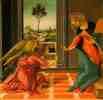
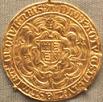
1489 The first known typhus epidemic in Europe starts in Spain - it's getting too full of shit? The plague ravages the Netherlands this year and next. On Feb. 14 queen (since 1474) Caterina (Catherine) Cornaro (1454-1510) of Cyprus is forced to sell her kingdom to Venice, leaving Nicosia dressed in black accompanied by her barons and ladies, her eyes filled with tears, after which on May 14 she sails away to Asolo County in Italian Veneto, where she is allowed to retain her title of queen, setting up a court known for patronizing art and lit. - anchors aweigh, baby? On Mar. 26 the 2nd Treaty of Medina del Campo between England Spain (first in 1431 between Portugal and Castile) provides for the marriage of Spanish princess Catherine of Aragon to Henry VII's eldest son Arthur Tudor (b. 1486), who on Nov. 29 is named prince of Wales. On Oct. 11 a revolt against new Scottish king James IV, led by Robert Lyle, 2nd Lord Lyle (-1497) and John Stewart, 1st Earl of Lennox (1429-95) (AKA Lord Darnely) (mad at being excluded from the govt. after helping James IV win) is defeated at the Battle of the Field of the Moss near the source of the Forth River; next Feb. the parliament annuls their forfeitures and placates them, and they support the govt., which gives seats in the royal council to the Angus, Argyll, Hepburn, Hume, and Huntly families - a full house? On Dec. 4 the Spanish capture Baza in Granada from the Moors after a 1-year siege. On Dec. 11 Jeannetto de Tassis is appointed postmaster of Innsbruck, going on to found the Thurn and Taxis dynasty that runs much of Europe's postal system. Her situation perilous, Anne of Brittany appeals to Maximilian I of Austria for protection - it's always wise to use protection? Former slave Yusuf Adil Shah (1459-1511) becomes ruler of Bijapur, India, founding the Adil Shahi Dynasty, which rules for almost two cents. Zurich mayor (since 1483) Hans Waldmann (b. 1435) is executed as a dictator. Abu Zikriya Yahya of Tunisia is overthrown by Abdul Mu'min (Abul Mumin). An embassy from Congo visits the king of Portugal. Sir Thomas Howard is released from prison and his earldom restored, and he is placed in command of the Scottish border defenses. The Bremen Brewers' Society is formed, becoming Germany's first brewing guild. Pope Innocent VIII suppresses the Order of the Holy Sepulchre and merges it with the Knights Hospitaler (Knights of St. John of Jerusalem) under grandmaster Pierre d'Aubusson (1423-1503); in 1496 Pope Alexander VI restores the order, with a new grandmaster taking the place of the old Franciscan custodian of the Holy Land, who continues to act as ex-officio Latin patriarch of Jerusalem until 1830 - let me upgrade you? 58-y.-o. Spanish-born Italian Cardinal Rodrigo Lanzol y Borgia (1431-1503) (Pope Alexander VI in 1492) takes gorgeous blonde 15-y.-o. bimbo Giulia Farnese (1474-1524) as his mistress; her hubby Orsino Orsini is "a good husband; he was blind in one eye, he knew how to wink with the other" (E.R. Chamberlin). The town of Vyatka in Russia comes under control of Moscow. Henry VII of England issues a charter to the city of Southwold. Peter Vischer the Elder (1460-1529) of Nuremberg becomes a guild master, going on to build up the family bronze foundry to #1 in Germany for the next half-cent. Henry VII of England authorizes the Gold Sovereign Coin to be minted, showing him seated on a throne on the obverse, with the royal coat of arms on a shield surrounded by the red-white rose of Tudor on the reverse; although it has no official markings of value, it is nominally worth one pound sterling (20 shillings or bob); even after Britain switches to decimal currency in 1971, it continues to be minted. Architecture: Palazzo Strozzi in Florence, designed on classic Roman principles by Benedetto da Majano (1442-98) is begun (finished 1507). Nonfiction: In 1489-91 Nuremberg, Germany-born geographer-cartograper (in Florence) Henricus Martellus Germanus (Heinrich Hammer) composes a World Map, showing a passage to the S of Africa along with a huge new peninsula E of the Golden Chersonese (Malaysia); shows no knowledge of the existence of the American continent. Johann Widmann (1462-98), Book on Arithmetic; the first use of the addition (+) and subtraction (-) symbols in mathematics. Art: Sandro Botticelli (1445-1510), The Cestello Annunciation. Hans Memling (1430-94), St. Ursula Shrine; gilden wooden reliquary with oil panel inserts, commissioned by the Hospital of St. John in Bruges. Births: French noble Charles of Bourbon-La Manche (d. 1537) on June 2 in Chateau de Vendome, Paris; son of Count Francois of Vendome (1470-95) and Marie de Luxembourg (1472-1547). French duke of Lorraine (1508-44) Antoine the Good (d. 1544) on June 4; son of Rene II (1451-1508) and Philippa of Guelders. Scottish queen (1502-13) Margaret Tudor (d. 1541) on Nov. 28 in Richmond Palace; eldest daughter of Henry VII (1457-1509) and Elizabeth of York (1466-1503); wife (1503-13) of James IV of Scotland (1473-1513) and Archibald Douglas, 6th earl of Angus (1489-1557); mother of James V of Scotland (1512-42), father of Mary Stewart, Queen of Scots (1542-87); the breed mare through whom James VI of Scotland (1566-1625) derives his claim to the English throne, ascending in 1603 as James I of England. French gen. ("the Thunderbolt of Italy") Faston de Foix, Duke of Nemoirs (d. 1512 on Dec. 10 in Mazres, Foix; only son of John of Foix, viscount of Narbonne and Marie d'Orleans; brother of Germaine of Foix, queen consort of Aragon, 2nd wife of Ferdinand II; paternal grandson of Gaston IV of Foix-Graily and Queen Eleanor of Navarre; maternal grandson of Duke Charles of Orleans and Marie of Cleves; maternal nephew of Louis XII. German Anabaptist leader Thomas Muntzer (Müntzer) (Münzer) (d. 1525) on Dec. 21 in Stolberg, modern-day Saxony-Anhalt. German humanist writer Johannes Cochlaeus (Lat. "spiral") (Dobneck) (d. 1552) in Wendelstein (near Nuremberg); educated at the U. of Cologne. English Protestant reformer-theologian-martyr (archbishop of Canterbury in 1533-55) Thomas Cranmer (d. 1556) on July 2 in Aslacton, Nottinghamshire; educated at Cambridge U. German Protestant statesman-reformer Jacob (Jakob) Sturm von Sturmeck (d. 1553) on Aug. 10 in Strasbourg; educated at the U. of Heidelberg, and U. of Freiburg. Italian Renaissance painter (Parma School) Antonio Allegri da Correggio (d. 1534) in Aug. in Correggio (near Reggio Emilia); nephew of painter Lorenzo Allegri; student of Lorenzo Costa. German Welf duke of Brunswick-Wolfenbuttel (1514-68) Heinrich (Henry) V (the Younger) (d. 1568) on Nov. 10 in Wolfenbuttel Castle; son of Duke Henry IV the Elder and Catherine, daughter of Duke Eric II of Pomerania. French duke Charles IV, Duc d'Alencon (d. 1525); son of Rene of Alencon and Margaret of Vaudemont; husband (1509-25) of Margaret of Angouleme (Navarre) (1492-1549), sister of Francis I. Italian condottiero Fernando Francesco d'Avalos (d. 1525) in Naples; of Spanish Aragonese origin. Spanish conquistador Juan de Grivalva (d. 1527) in Cuellar, Castile. Scottish stud Archibald Douglas, 6th Earl of Angus (d. 1557) in Douglasdale, Lanarkshire; grandson of Archibald Douglas, 5th earl of Douglas; 2nd husband (1514-) of Henry VIII's sister Margaret Tudor (1489-1541), with whom he has Margaret Stewart (1515-78), grandmother of James VI/I. French Protestant reformer William (Guillaume) (Guilhem) Farel (d. 1565) in Gap, Hautes-Alpes; student of Jacques Lefevre d'Etaples (1455-1536). French treasurer-gen. and bibliophile Jean Grolier de Servieres (Servičres), Viscount d'Aguisy (d. 1565) (b. 1490?) in Lyon; inventor of Grolier-style bookbinding (gilt ornamentation with geometric patterns); motto: "Of or belonging to Jean Grolier and his friends". Ottoman chief architect (1538-88) Koca Mimar Sinan Aga (d. 1588) in Agirnas (Mimarsinankoy) (near Kayseri); born to a Christian family and christened Joseph. Deaths: Dutch reformer-scholar Wessel Gansfort (b. 1419) on Oct. 4 in Groningen; his writings, later praised by Luther are later suppressed by the Church, and the 1st ed. of the remnant is not pub. until 1520: "Studious boy, you will live to see the day when the teachings of... quarrelsome theologians will be rejected by all true Christians."